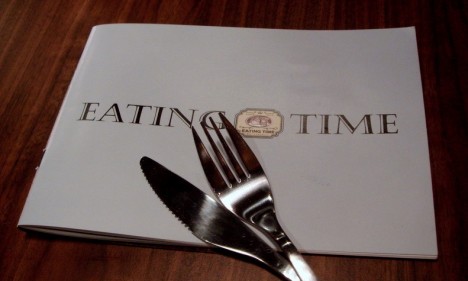
(CC BY-NC-ND 2.0) MiniQQ/Flickr
Here’s a question to ponder: Why do we eat three meals a day? Of course, many of us don’t actually eat three meals a day on a consistent basis; breakfast skippers are a significant demographic all by themselves. But this is a cultural question, like asking Why do we drive on the right side of the road, even though a lot of us don’t drive. In general, however, we are motorists, and in general, we partake of breakfast, lunch and dinner.
So: Why three meals? Why not two or five? Is there something inherently beneficial about the holy trinity of food consumption? Given the way that the three-meals tradition has produced, or at least not impeded, our soaring overweight and obesity rates, that argument would seem to be a tough sell.
Origins of the three meals pattern
In fact, the three-squares-a-day pattern traces back to Medieval Europe if not earlier. And in those days, breakfast, lunch, and dinner didn’t mean what they mean today. Our forebears hadn’t the time to start the day preparing and eating what we, or at least the food industry, call a “hearty breakfast.” There were chores to get at, one’s livelihood to be earned, and that meant grabbing something fairly quick, which could mean anything from cold mush and raw vegetables to brown bread and ale.
The main meal in terms of sheer quantity was the one taken at mid-day, in order to re-fuel the body, and it was generally either unpacked and consumed in the fields or enjoyed in the kitchen, depending on how far one’s labors took one from one’s home. It was called dinner, and might take place at anytime between noon and late afternoon. Supper, the evening meal, was often little more than an afterthought, and consisted of whatever could be prepared, eaten and cleaned away before nightfall made the whole process more difficult.
Our American meal schedule developed to reflect the industrial revolution, with fixed working hours independent of sunrise and sunset times. Meal scheduling became simpler and more routinized. We had breakfast before leaving for work, lunch when our employer’s lunch period was scheduled, and dinner at some point after returning home from work.
But this neat, predetermined dining pattern has fallen into disarray, and dietitians are increasingly raising the possibility that it has become an anachronism. A number of factors, from flex-time jobs and the growth of temp and self-employed occupations to family members with conflicting schedules, have increased our freedom to eat at our own chosen times, and fast-food chains and coffee shops are now routinely 24-hour operations, promoting the availability of breakfast, or any other meal, whenever you want it.
Alternatives to three meals a day
One aspect of this revolution in our eating pattern has been that researchers have begun asking the question, “Since we can now take our meals whenever we want, when would be the healthiest times to do so? And how many meals would be best?” The answers so far, if you can even call them that, are all over the lot, and often at odds with one another. Chew over the following.
According to a USDA study, substituting one big meal per day for three modestly sized meals will cut our weight and body fat. But it will raise our blood pressure, while the three-meal format lowers it. And a study conducted by the National Institute on Aging found that the one-big-meal-a-day pattern increased diners’ insulin resistance and glucose intolerance, setups for type 2 diabetes.
Meanwhile, U.C. Berkeley researchers reported that alternate-day fasting, alternating between eating a whole lot on day and nothing at all the next, seemed to lower the risk of cancer and heart disease. And the National Institute on Aging, clearly a busy organization, compiled 20 years worth of research on periodic fasting and found that it produced leaner physiques, healthier brain cells, and longer life spans. Which would be highly encouraging, if the experiments hadn’t exclusively involved mice.
Speaking of mice, the Salk Institute found that those who are only allowed to eat during fixed eight-hour periods (the way CalorieLab’s Dr. J eats) get fewer metabolic diseases than those allowed to eat at will.
Then there’s the British Journal of Nutrition study in which researchers wondered how the number of daily meals effected one’s weight and metabolism, and so had one group eat three a day and another group eat six, the total calories being equal. The result: Nothing. Absolutely no difference. Just to make sure, the University of Warwick conducted a follow-up study comparing two-daily-meal and five-daily-meal groups. Same outcome.
And recent studies of breakfast consumption have pretty much concluded that it doesn’t matter to your weight or general health whether you eat one regularly, occasionally, or never.
And those are just the findings of U.S. researchers. On an international level, things get even more capricious.
While breakfast may be immaterial here at home, a Dutch study found that breakfast-skippers there are five times more likely to become obese than breakfast regulars. The study also found that people who “graze” rather than take full meals, consuming their food in at least four smaller meals per day, are 45 percent less likely to become obese.
Nuts to that, said Canadian researchers, who found that smaller, more frequent meals did zilch to control weight, while French scientists agreed, reporting that pro-grazing studies were methodologically full of baloney.
To quote the Magic 8 Ball, the answer is murky
By now you’re probably getting the picture. To the “Meals: how many and how often?” question, we have no verifiable answer. Maybe we’ll come up with one, but don’t hold your breath. And more importantly, don’t believe anyone who claims to have discovered one. There are so many interactive factors involved, such as diet and nutrition, physical activity, physiology, genetics, circadian rhythms and more, that there is probably no universally “best” eating pattern out there to be discovered.
Maybe alternate fasting will work for you. Maybe one big meal and four snack pauses. Maybe only eating between 6 a.m. and 8 p.m. There’s only one way to find out: trial and error. In the meantime, there is probably one rule of thumb that will work for almost everybody who would like to reduce or control their weight.
Eat only when you are genuinely hungry, and then, eat only until you no longer are.
It’s a simple rule. Unfortunately, if it were also an easy one to follow, we would be a nation of swimsuit models.

By Robert S. Wieder, CalorieLab’s Senior Health Columnist since 2006. Author of several books, including 115 Reasons Why It’s Not Your Fault You’re Fat, Bob wrote for numerous national magazines after starting out as editor of the UC Berkeley humor magazine the California Pelican. He also put in a stint as a San Francisco-area stand-up comic.
When and How Often Should You Eat? is a post from:
SOURCE: – Read entire story here.




